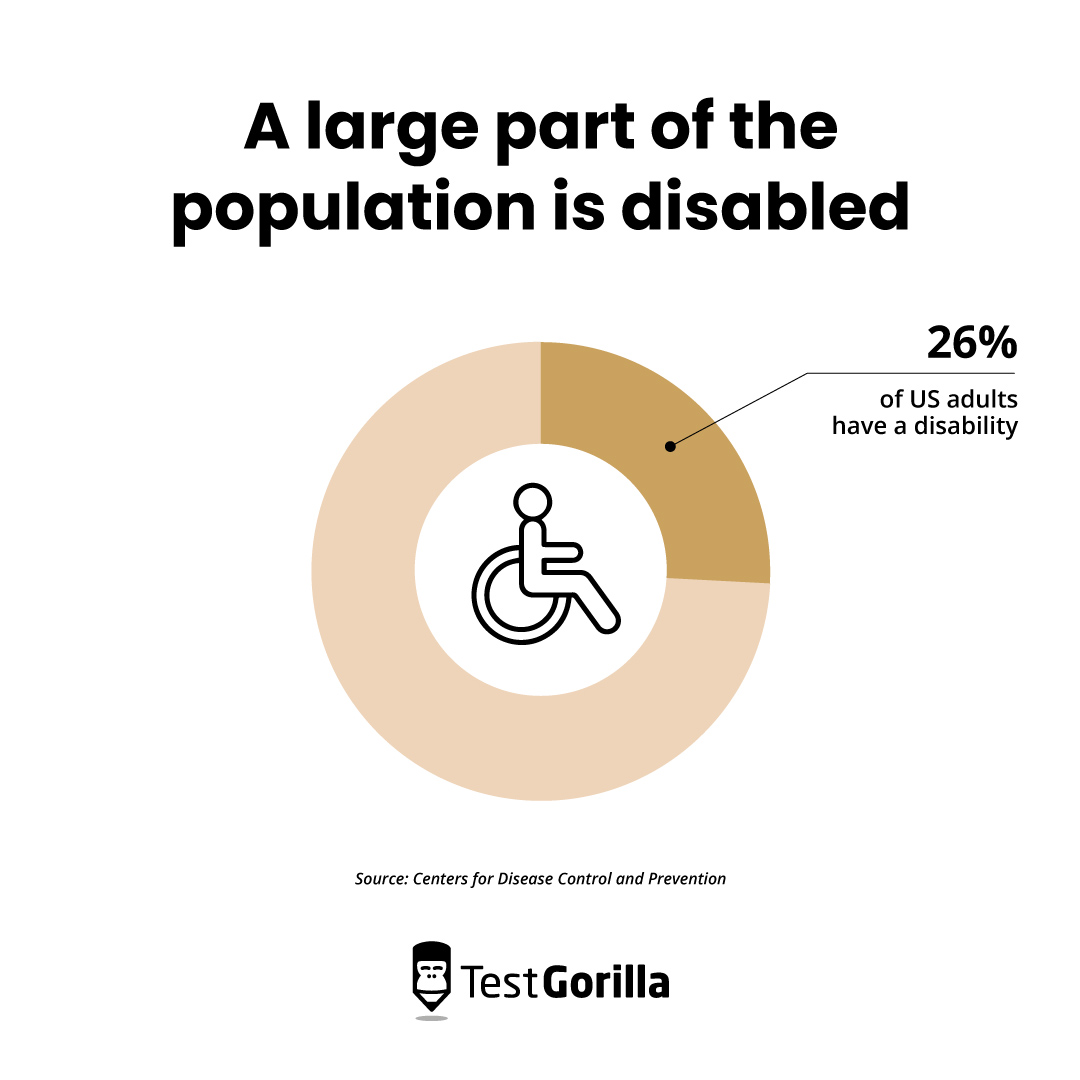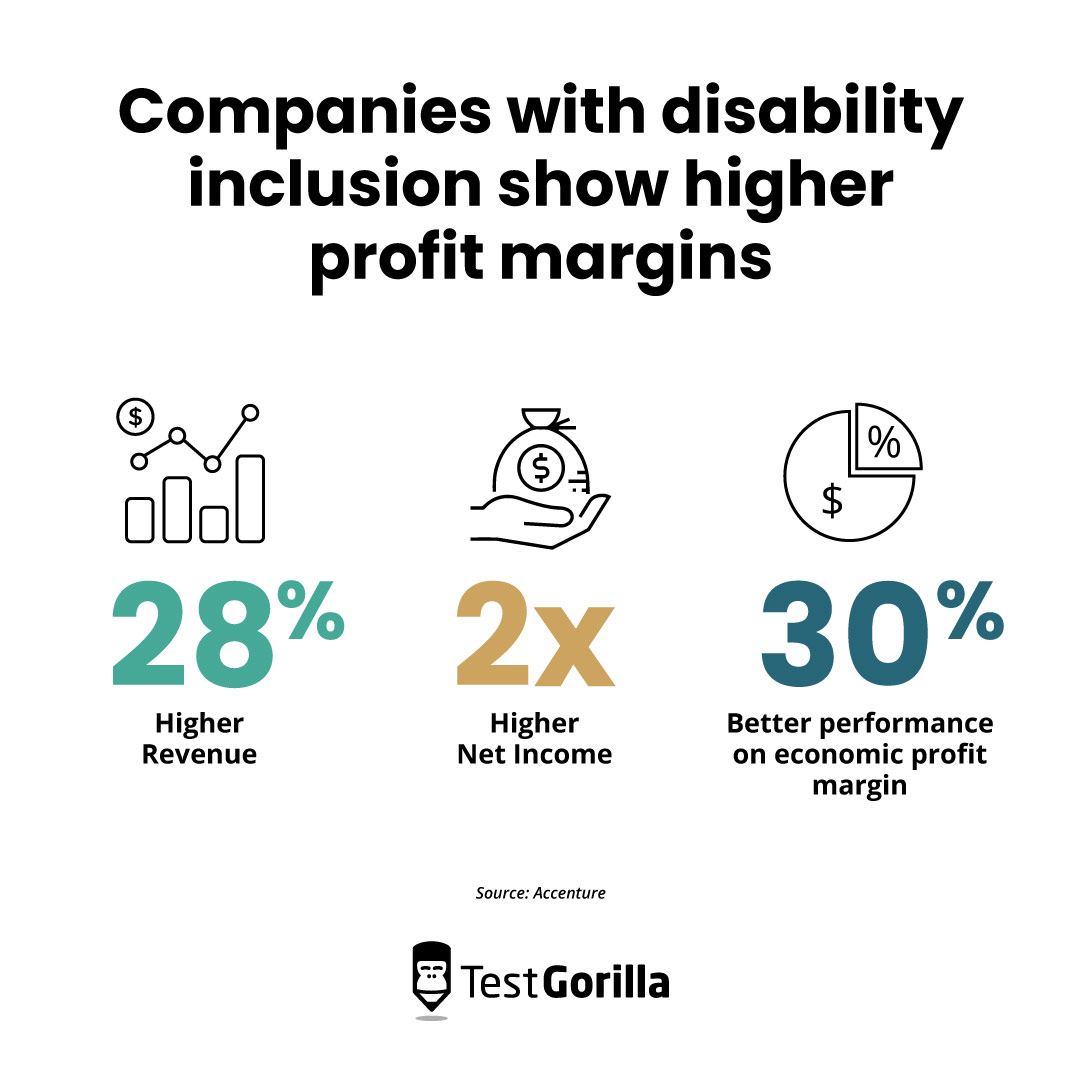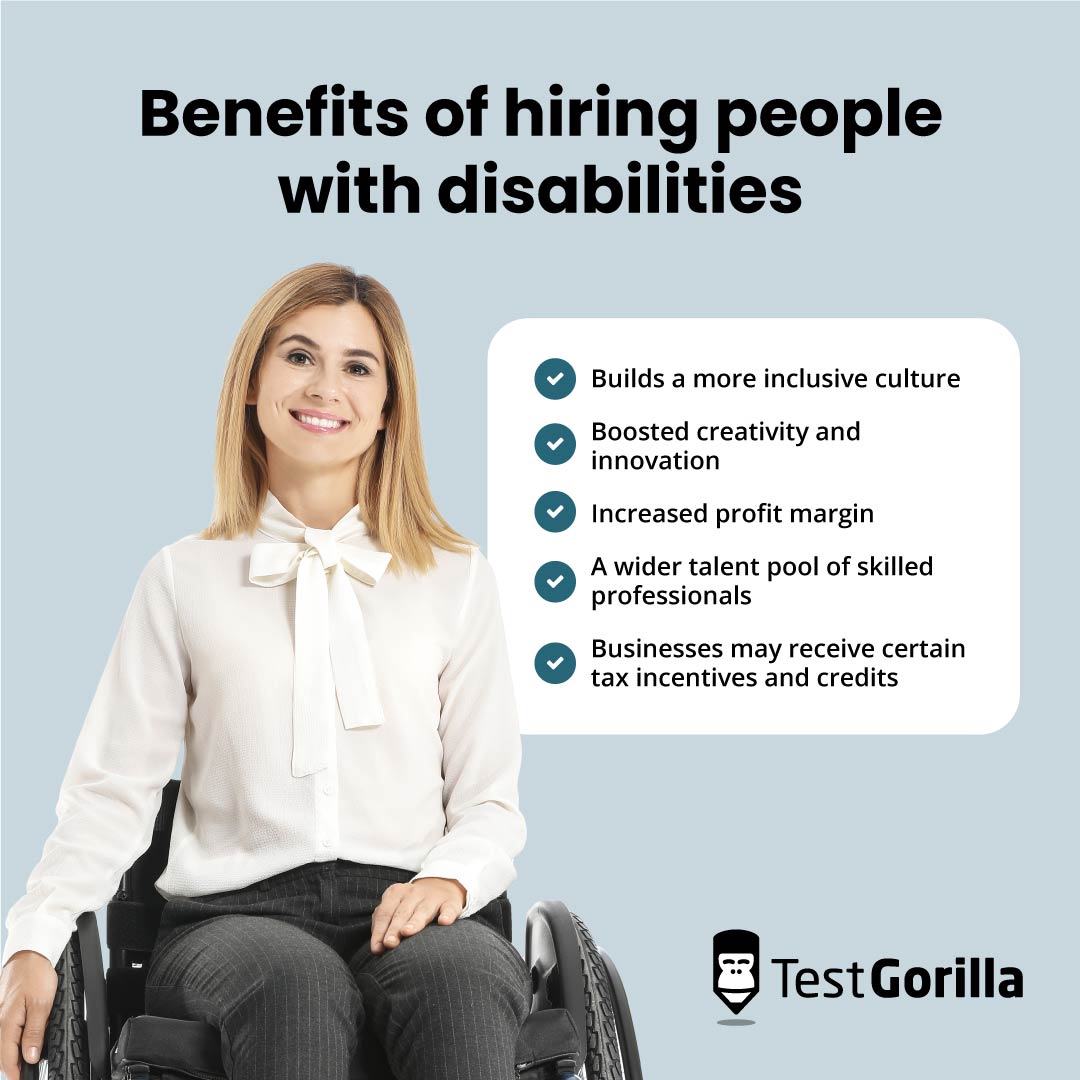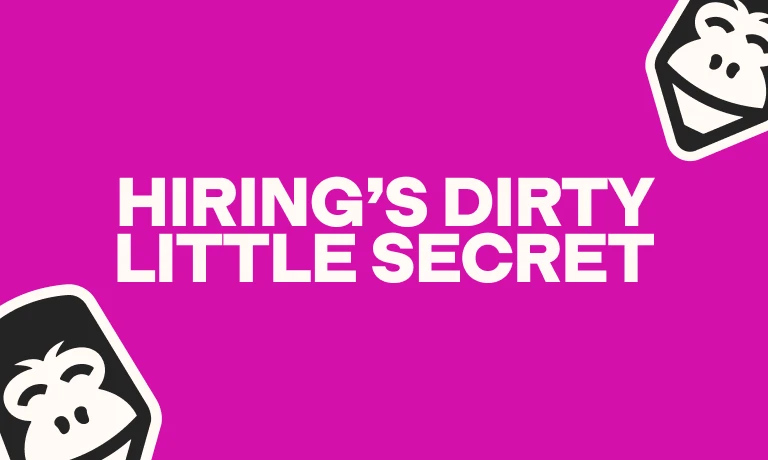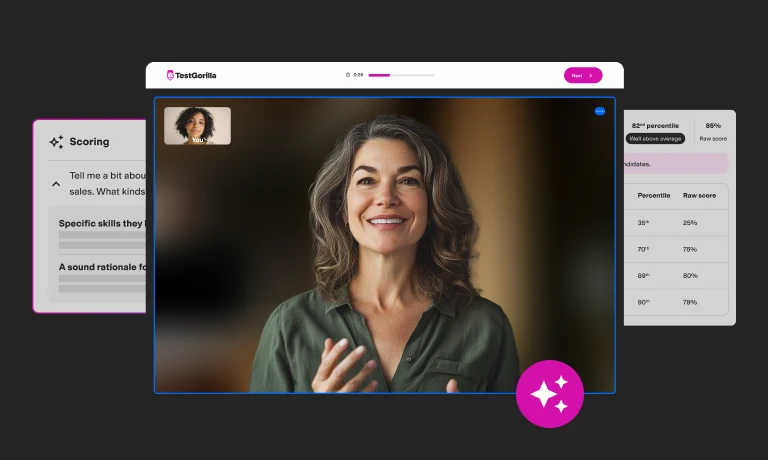Hiring people with disabilities: How talent assessments offer equal opportunity
Hiring people with disabilities is important to your people strategy and provides your workplace with key benefits.
These people form a large part of the population – 26% of US adults have a disability.[1]
Disabilities include:
Visible disabilities, including people who use wheelchairs or amputees
Invisible disabilities, including autistic people or those with fibromyalgia
However, traditional hiring practices make this process challenging. Requiring college degrees, for example, limits your talent pool because many disabled job seekers don’t have one.
How do you build a recruiting process inclusive of workers with disabilities?
Talent assessments gauge skills objectively and toss away the need for requirements like degrees. They also nurture an inclusive culture.
This blog explores the benefits of hiring people with disabilities and our strategies for how talent assessments can help any organization, from a small business to a nonprofit.
Feel free to skip ahead to the tips if you already know the benefits and challenges of hiring disabled employees.
Table of contents
- The difficulties with hiring people with disabilities
- How talent assessments help companies hiring people with disabilities
- 6 ways to use talent assessments to optimize hiring people with disabilities
- Beyond talent assessments: 3 best practices to remember for hiring people with disabilities
- Hiring people with disabilities is easier than ever with talent assessments
Builds a more inclusive culture
Hiring more people with disabilities shows your workforce that you value diversity and inclusivity.
This practice builds a good company culture and shows you accept people for who they are.
Building a workplace with disability inclusion also increases your workforce’s understanding of people from different backgrounds, leading to better communication and team collaboration.
Boosted creativity and innovation
Disabled people come from vastly different backgrounds and walks of life and carry a strong ability to discover new solutions and innovate.
Hiring more employees with disabilities gives your workforce new opinions and perspectives, which helps create new ideas and solve problems.
Creative industries are well-suited for neurodivergent minds because of their different perspectives. If you’d like to read more, head over to our article on designing for neurodiversity.
Increased profit margin
Companies with higher disability inclusion show much higher profit margins.
A study found that companies with outstanding leadership in disability empowerment had, on average, 28% higher revenue, double the net income, and 30% higher profit margins.[2]
This point adds to the first two benefits we discussed: Increased innovation and better workplace inclusion make teams with disabled employees more profitable.
The boosted creativity speaks for itself, but how does inclusion boost profits? Disabled people are a large demographic eager to find companies that support them, and adopting inclusive practices helps convey that message loud and clear.
A wider talent pool of skilled professionals
As mentioned earlier, hiring people with disabilities means including 26% of the US adult population – or 65 million more potential job applicants – in your talent pool.
Creating a more inclusive hiring process helps when hiring millennials. This group of people accounts for the largest part of the workforce, and a third of them have a disability of some type.
Hiring people with disabilities also helps when hiring Gen Z – 99% of Gen Z’ers say that workplace DE&I is important to them, and 80% say that they’d be more likely to apply for a job inclusive to neurodivergent people.
Businesses may receive certain tax incentives and credits
Companies hiring people with disabilities may be eligible for certain financial incentives from federal agencies. A few common ones include:
Trainee wage reimbursement
The work opportunity tax credit
Trial work program
Reimbursed on-the-job training programs
Federal and state tax credits
Always consult a legal professional for details on this process to understand what you’re eligible for.
We talk more about legal matters below.
The difficulties with hiring people with disabilities
Despite the many benefits of hiring people with disabilities, companies also face certain challenges when trying to find the right candidate.
Here are the three main difficulties.
1. Accurately and fairly evaluate disabled people
Hiring people with disabilities can be tricky when you use only one way of hiring. Disabled candidates have different needs, so using the same methods could give you an inaccurate view of a candidate’s skills.
Evaluating candidates with equal measures isn’t the same as using fair measures.
For example, neurodivergent people could freeze up on short timers and provide the wrong answer to a question they knew the answer to.
Non-disabled workers may not need accommodations like extra time or breaks, but these simple things help level the playing field to create an equal experience.
2. Ensure disabled candidates have the qualifications you seek
Recruitment can be difficult when many workers with disabilities lack traditional qualifications like college degrees.
One study found that 24.9% of disabled people had a degree as their highest qualification compared with 42.7% of non-disabled people.
Further, 13.3% of disabled people had no qualifications compared with only 4.6% of non-disabled people.
These barriers narrow the number of disabled candidates who can even pass the initial application stage.
The worst part is that you don’t require these traditional job “requirements.”
Most positions don’t need four-year degrees and years of experience for success, so it’s entirely in the hiring manager’s power to remove them.
3. Address disabled candidates' specific needs in the workplace
Many employees with disabilities have special workplace needs, and companies don’t have the processes to comfortably accommodate them.
These accommodations include every stage of the hiring process, from optimized careers pages with alt text for the hearing impaired to offering mentors during new employee onboarding.
Some organizations also believe that workplace accommodations are expensive or hard to acquire when reasonable accommodations can be as simple as helping employees set boundaries.
The application process can also be tricky to get through without accommodations. For example, a talent assessment should include text-to-speech functionality to be fully inclusive.
Check out our blog on reasonable accommodation for our full guide on the topic.
How talent assessments help companies hiring people with disabilities
Now, let’s look at how talent assessments help tackle these challenges and make hiring people with disabilities simple and fair.
Accurately evaluate every person
Talent assessments objectively and fairly assess skills and competencies. They enable hiring managers to focus on skills, not unreliable resumes and college degrees that not every qualified person has.
Talent assessments strip away everything but what matters: whether or not you can perform the role successfully.
They also enable recruiters to offer special accommodations to disabled candidates to level the playing field, such as giving extra breaks between tests for an autistic candidate who could easily get overwhelmed.
Create a culture of inclusivity where you value people for their skills
Adopting talent assessments and skills-based hiring builds a healthy, accepting culture. They create an organization where you value people for their skills, not their connections or backgrounds.
This atmosphere is naturally more welcoming to disabled candidates and increases the number of disabled applicants interested in your company.
A workplace that values employees for their skills and performance also helps boost the retention rate of disabled employees.
We recommend building this culture naturally through skills-based hiring, but it’s also a good idea to take a proactive approach, such as offering disability awareness training.
Reduce unconscious bias
Every person can have unconscious biases, and often, we’re never fully aware of them – hence, they are unconscious.
Talent assessments combat unconscious bias by assessing a person’s skills, personality, and culture.
Evaluating skills eliminates the unconscious bias against disabled candidates, such as a lack of eye contact or a perceived lack of empathy.
It enables us to see past them and hire the ideal candidate for the position, regardless of our instinctual perceptions.
The best insights on HR and recruitment, delivered to your inbox.
Biweekly updates. No spam. Unsubscribe any time.
6 ways to use talent assessments to optimize hiring people with disabilities
Hiring people with disabilities brings innovation and inclusivity into your organization, so it’s time to remove the barriers in the hiring process that hold them back.
Here are our top ways that talent assessments help hire workers with disabilities.
Strategies for hiring disabled candidates with talent assessments: A summary
Strategies | Description |
1. Use talent assessments to gauge every candidate fairly | Shortlist candidates based on objective test scores |
2. Offer special accommodations | - Enable candidates to use accommodations, such as text-to-speech and extra breaks - Enable this function easily in your assessment account |
3. Stop relying on college degrees and resumes | Find quality candidates by assessing candidate quality with talent assessments instead |
4. Reach out remotely to find people who have trouble with mobility and commuting | - Include candidates with motor impairments by using remote-friendly hiring methods - Use talent assessments to gauge skills from afar |
5. Evaluate candidates with culture add, not culture fit | - Drop reliance on culture fit because it perpetuates a homogenized culture - Hire for culture add, which encourages diversity |
6. Use talent assessments to build accurate job descriptions | - Discover your true hiring needs by using talent assessments to help you spot the right skills - Write a skills-based job description that helps you find relevant candidates |
1. Use talent assessments to gauge every candidate fairly
It’s one thing to say that talent assessments enable you to evaluate every candidate’s skills fairly, but let’s take a closer look at how.
First, you send candidates talent assessments. These assessments usually take the place of applications and resumes.
Then, each candidate completes their assessment containing three to five tests. When they finish, you receive the results.
An assessment program like TestGorilla enables you to shortlist candidates automatically based on their test scores. Here’s what it looks like:
You can see from this screen that Johnny Sinatra scored 84%. From here, we can click on the candidate’s name to get a closer view of their results and get insights into their score.
Using talent assessments lets you choose a candidate based on their skills and capabilities. It gives you visibility into which tests they scored highest and which skills gaps could be a future area of improvement.
This process lets you evaluate all candidates fairly and plan future training initiatives.
Talent assessments are naturally fairer but can be even more inclusive to disabled candidates when introducing special accommodations.
2. Offer special accommodations
Some disabled candidates may need a few accommodations to perform the same way as others, like how a person in a wheelchair needs a ramp to enter a building the same way as others.
Talent assessments offer accommodations to candidates to help them complete tests comfortably.
Here are a few examples of skills test accommodations:
Extra time
Extra breaks
The option to answer tests verbally
Text-to-speech functions
And here’s how you enable special accommodations in a TestGorilla skills assessment:
After you finish putting an assessment together and you’re at the last step (Review and Configure), scroll down to “Advanced Options”.
From here, click the drop-down arrow on “Accommodation for Candidates”:
When you tick these boxes, TestGorilla enables candidates to opt into accommodations before they start their assessments.
If you’d like to read more, check out our guide on special accommodations for skills tests.
3. Stop relying on college degrees and resumes
Traditional hiring practices rely heavily on certifications and years of experience, which makes them unreliable for hiring people with disabilities.
Many workers with disabilities lack traditional job requirements and have gaps in their work history.
In the past, it was difficult to determine if a candidate had the skills your role needed, but we didn’t have any other way to tell.
Our survey shows some of the problems that companies have with resumes:
38% of employers said that resumes weren’t effective
56.9% said that they couldn’t tell if the candidate had the right skills from their resume
44.6% said that the only method they have for gauging applicants is through years of experience
The good news is that we no longer have to rely on resumes – we have more advanced methods of qualifying candidates.
With talent assessments, you have a superior way to gauge a candidate’s capabilities and quality, so you can give resumes the boot.
Talent assessments also enable you to find candidates who match most of your needs but not all, enabling you to find a good hire and then upskill them through employee training and workforce development.
4. Reach out remotely to find people who have trouble with mobility and commuting
Thousands of people with mobility issues rely on remote work, and if a company is obsessed with a return to office, it’s missing out on great talent.
Motor impairments are the most common type of disability: 39 million Americans live with one.[3]
Plus, many freelancers are disabled, which means you need to consider workers with disabilities and remote recruitment when hiring a contractor.
You can facilitate your remote hiring strategy by sending candidates objective skills tests once they see your job posting and apply.
Talent assessments are the number one hiring method for recruiting remote talent.
They remove obstacles that stop companies from hiring remote employees, such as relying on in-person evaluations.
They also enable you to test for skills that help remote work, such as time management and following instructions.
Further, talent assessments can help you gauge candidates from afar when you use them as a part of your virtual job fair, an effective part of your inclusive hiring strategy.
5. Evaluate candidates with culture add, not culture fit
Culture fit is a traditional way to evaluate whether a candidate suits your company, but we believe it’s overstayed its welcome.
This system gauges whether or not a candidate “fits” into a culture, which can be problematic and encourage a homogenized team.
It stifles innovation and also screens out people from different backgrounds, like candidates with disabilities.
On the other hand, hiring for culture add makes a more inclusive culture for disabled folks and optimizes diversity hiring.
Culture add evaluates candidates on what they add to your culture and work environment, gauging them for similar values and welcoming diversity and unique opinions.
Talent assessments enable you to gauge this with a simple Culture Add test. You fill out a questionnaire describing your company culture, and the test hires candidates based on their alignment with it.
Culture fit is on its way out, but hiring for culture add is easy and effective.
6. Use talent assessments to build accurate job descriptions
A clear job description helps you discover your hiring needs, attract the right candidates, and find the best talent.
It also helps you toss away any “requirements” that aren’t strictly necessary, such as years of experience.
You can use talent assessments to see which skills are necessary for a role.
Use skills tests to evaluate employees in similar roles to determine the key skills for a position, then tailor-make a description based on the real capabilities used in the role.
For example, you’d need different talent assessments for veterans’ employment than for apprenticeships.
Talent assessments are a key component to building skills-based job descriptions, which are essential for clarifying your needs, creating an inclusive hiring process, and reducing mis-hires.
Beyond talent assessments: 3 best practices to remember for hiring people with disabilities
Talent assessments streamline hiring people with disabilities but aren’t the only thing that helps.
Here are a few best practices to remember to help you offer and support employment for people with disabilities.
Best practices for hiring people with disabilities: A summary
Strategy | Description |
1. Reach out to diverse hiring organizations | Build a relationship with communities that provide disabled employees with opportunities |
2. Commit to structured interviews | Use structured interviews and reduce reliance on charisma and appearance |
3. Ensure you know and follow the law | Consider legal concerns and ensure you seek professional help |
1. Reach out to diverse hiring organizations
Reach out to communities, job boards, and organizations that provide disabled employees with opportunities.
Many organizations and networks help connect employers to disabled professionals, and it’s well worth your time to build a relationship with them.
One example is Power to Fly, a community committed to supporting diverse individuals and helping them find work. It has many resources to help companies that hire people with disabilities, such as virtual job fairs.[4]
You can also take advantage of the Job Accommodation Network. Provided by the U.S. Department of Labor, it lets employers discover a wealth of information about hiring and retaining people with disabilities.
2. Commit to structured interviews
Traditional unstructured interviews rely on appearance, charisma, and confidence and can severely impact a disabled candidate’s performance and outcome.
For example, a common expectation during an unstructured interview is that a candidate maintains eye contact, something that’s difficult and uncomfortable for autistic people.
We recommend conducting structured interviews. These interviews have a prewritten script and predetermined criteria, so it doesn’t matter if the candidate maintains eye contact – what matters is whether or not they meet your criteria.
Structured interviews are also much more effective at predicting job performance.
One study found that structured interviews predict up to 26% of job performance, whereas unstructured interviews predict only 14%.[5]
Writing interview scripts in advance also helps you follow the guidelines for interviewing people with disabilities.
3. Ensure you know and follow the law
There are certain legal concerns when hiring people with disabilities.
You need to understand the disability employment provisions of the Americans with Disabilities Act (ADA) and comply with other requirements of the federal government.
One of the most common and important concerns is that employers cannot refuse someone owing to their disability, which is another way talent assessments can help.
They give you objective reasoning for refusing a candidate to reduce the chance of accusations.
Another important legal concern is the strict rules regarding disability-related inquiries in job interviews. Here are a few of them:
Before an offer of employment, an employer cannot ask any disability-related questions, even if they're related to the job
After they offer an applicant a job, but before they start work, employers can ask disability-related questions, regardless of whether they are related to the job, as long as they do so for all employees in the same job category
After employment begins, an employer can make disability-related inquiries only if they are job-relevant[6]
Recommended reading: Full guide to illegal interview questions
Disclaimer: The information contained in this site is provided for informational purposes only and should not be construed as legal advice on any subject matter. If you have any questions about hiring disabled people, please consult a lawyer.
Hiring people with disabilities is easier than ever with talent assessments
Hiring people with disabilities enriches your company with much-needed creativity and problem-solving skills, so it’s worth tackling the challenges that come with it.
Use talent assessments to make the process easy.
Focusing on a candidate’s skills and personality makes it simple to disregard a candidate’s background, including work gaps or lack of certifications.
Rely on talent assessments, and you can:
Give resumes the boot
Gauge candidates on their culture add
Evaluate their skills objectively
Reduce hiring bias.
If you’d like to read more on that last topic, check out our post on bias in hiring and how you can reduce it.
To look at more than 300 talent assessments, browse our test library and brainstorm your next hiring assessment.
Sources
1. "Disability Impacts All of Us". (May, 2023). Centers for Disease Control and Prevention. Retrieved September 11, 2023. https://www.cdc.gov/ncbddd/disabilityandhealth/infographic-disability-impacts-all.html
2. “Companies Leading in Disability Inclusion Have Outperformed Peers, Accenture Research Finds”. (October 29, 2018). Accenture. Retrieved September 15, 2023.https://newsroom.accenture.com/news/companies-leading-in-disability-inclusion-have-outperformed-peers-accenture-research-finds.htm
3. "Disability Statistics in the US: Looking Beyond Figures for an Accessible and Inclusive Society". (April 8, 2022). Inclusive City Maker. Retrieved September 11, 2023. https://www.inclusivecitymaker.com/disability-statistics-in-the-us/
4. "Find belonging at work and beyond". Power To Fly. Retrieved September 11, 2023. https://powertofly.com/
5. Bock, Laszlo. (April 7, 2015). "Here's Google's Secret to Hiring the Best People". Wired. Retrieved September 11, 2023. https://www.wired.com/2015/04/hire-like-google/
6. "Questions and Answers: Enforcement Guidance on Disability Related Inquiries and Medical Examinations Under the Americans with Disabilities Act". (2009). U.S. Equal Employment Opportunity Commission. Retrieved September 11, 2023. https://www.eeoc.gov/laws/guidance/questions-and-answers-enforcement-guidance-disability-related-inquiries-and-medical
You've scrolled this far
Why not try TestGorilla for free, and see what happens when you put skills first.


